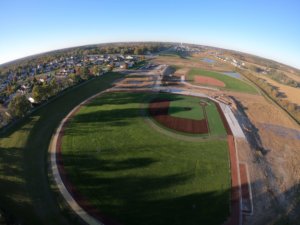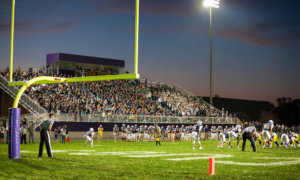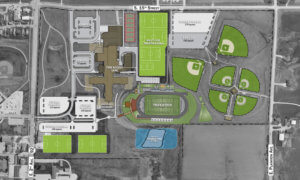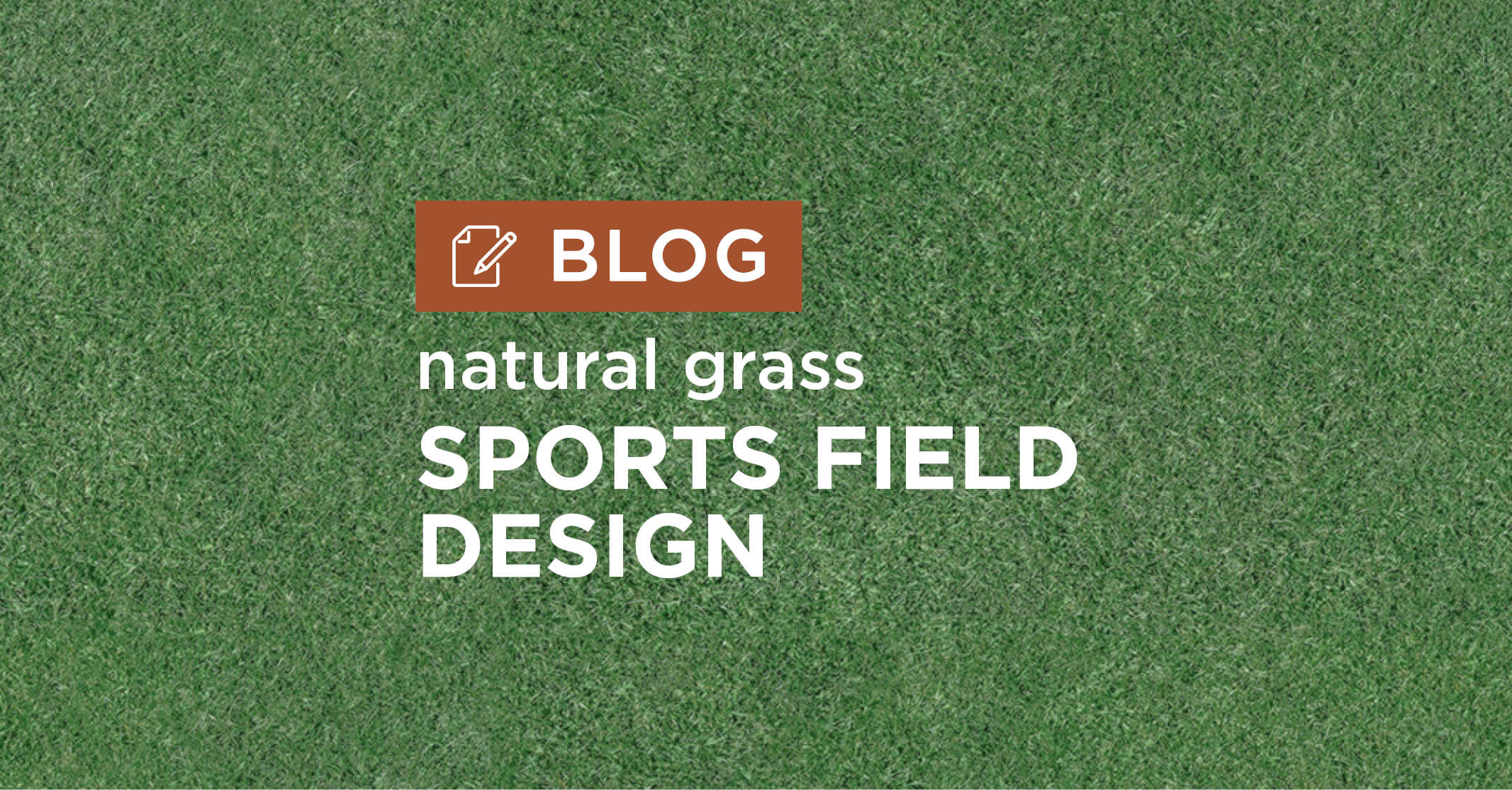Key Aspects of Designing Natural Grass Sports Fields
Do you have a natural turf athletic field with worn-out, hard spots? Have you had to cancel games due to muddy field conditions? If your grass sports field doesn’t live up to your needs and expectations, there are several aspects of natural turf design that could be the cause. “Artificial and natural grass turf have significant differences, and how your sports field performs is influenced by a variety of factors,” explains Clay Schneckloth, PLA, of Snyder & Associates. “A turfgrass field needs a strong root system to flourish and withstand repeated use. And establishing a strong root system begins with the right conditions.”
When it comes to creating the right conditions, Schneckloth says seven core aspects of athletic turf design come into play to make sure the field is ready for game day.
1. Level of Play & Amount of Use

To accommodate the anticipated level of play and amount of use, McFarland’s new varsity baseball field combines a synthetic turf infield with a natural turf outfield. The junior varsity diamond, pictured in the upper right corner, features a dirt infield with a natural turf outfield.
The first thing to consider is the level of play, the amount of use, and type of sport(s) being played on your field. Is your sports field going to be used for recreational or high-end, collegiate competition? Determining this will help guide the design process.
What expectations do you have for the quality of your natural grass turf? This will have an effect on the budget, manpower, and resources needed.
It’s also important to discuss the amount of use that’s anticipated for the field. How frequently will the field be used, and what type of sports will it be used for? How quickly do you want to play on the field after it rains? How many tournaments will be held on the field? Sometimes a sports field gets used five times a day during tournaments or just once a week.
Understanding the amount of use you anticipate guides the turfgrass selection and maintenance recommendations so that the field can recover between events. Both the Ames Athletic Complex and McFarland School District Facility Improvement projects illustrate how the level of play and amount of use have a strong impact on athletic facility design.
2. Athletic Facility Budget
Whether it’s designing and building a new sports field or rehabbing an existing field, the budget always plays a big factor in determining the type of natural grass turf and field components that will be included. There are many elements that contribute to a high-quality, healthy sports field, including soil type, turfgrass species, subdrain system, irrigation, and maintenance. And they each have a price tag. With an understanding of the budget, we’ll guide you in reaching informed decisions about which components and options are best suited for your athletic facility needs.
When it comes to funding, the excitement and enthusiasm for an upcoming project can help with fundraising. Use that excitement to your advantage. The word will spread quickly. Booster groups are a great resource. Keep them included in the design process by inviting them to meetings. It’s amazing to see people take ownership of a sports field project and be proud of the finished recreational facility. For example, the Nevada Athletic Booster Club stepped up to the plate and financially supported a fun feature at their new high school baseball field.

The Nevada Cubs Stadium has a natural turf field comprised of Kentucky bluegrass and perennial ryegrass. Drainage and irrigation components were included during field construction to assist with turf establishment and long-term health.
3. Soil Composition
Belowground sports field features don’t have the exciting glitz and glamor of aboveground features, but they’re essential building blocks nonetheless. Don’t skimp on these. Understanding the existing soil conditions onsite guides the subdrain design and maintenance procedures.
As was the case with the Nevada Cubs Stadium project, sometimes, the existing soil conditions aren’t ideal for a top-performing natural turf field. Having soil borings and analysis done by a geotechnical engineer will help eliminate the guessing game. They’re also able to provide recommendations for nutrient applications or amendments, which is a valuable time saver.
Don’t forget about getting an analysis of imported soil as well. Using a geotechnical report, poor quality soil can be amended.
4. Turf Species
Understanding the differences between Kentucky bluegrass, perennial ryegrass, and tall fescue can be overwhelming, but it doesn’t have to be. We regularly consult with industry experts to guide the selection of natural turfgrass species and have developed a keen understanding of their differences.
For example, tall fescue can handle substantial traffic, but it can be clumpy and not as smooth as you may desire. Perennial ryegrass is quick to germinate. On the other hand, Kentucky bluegrass takes longer to germinate but provides a smooth, uniform blend. However, some varieties of Kentucky bluegrass take longer than others to turn green. If you have early spring athletic events, we might want to look into a blend that’s geared toward early spring green up.
Once you’ve established a healthy stand of grass, overseeding is needed to maintain it. Wear and tear will create spots that need TLC. Understanding upcoming weather, uses, and expectations all come into consideration when fixing worn out spots. From time to time, seeding rates may need to be adjusted. You’re not the first person to experience this. Be sure to ask questions.
Understanding your natural turf expectations helps us design with your specific needs in mind.
5. Subdrain System
An underground subdrain system is a valuable component of a healthy, playable sports field. It can be a hard sell, but it’s necessary. Allocating resources for soil and subdrain improvements during initial construction may reduce available funds for other components, but it’s more expensive and difficult to add these improvements in the future. Surface drainage of surrounding areas should be considered. Try not to drain water from a hillside across your sports field. You should only be draining what stormwater falls on your field. This water can be collected and redirected away from your sports field. The amount of drainage needed is determined by the soil, drainage areas, and budget.
6. Turf Irrigation

All six soccer and practice fields at Indianola Middle School have integrated and centrally controlled irrigation systems featuring high-efficiency technology to reduce water use and allow for easy monitoring.
Irrigation will be needed for certain types of natural turf species. The soil type will also determine the amount of water needed. Sand-based soils need more water than native soil based fields. An irrigation system helps keep Kentucky bluegrass and perennial ryegrass performing to their full potential. The amount of water, whether too little or too much, will affect growth.
The irrigation system should be frequently monitored and not just set to a schedule. Moisture monitoring is the key, and natural turf should be watered deep. Shallow watering will not allow the roots to properly develop. An integrated and centrally controlled irrigation system, like the one used on the Indianola Community Athletic Fields project, can assist with irrigation and monitoring. Remember, we need to be good stewards of water both on and off the field.
7. Maintenance Plan
Maintenance should be discussed and accounted for during the field design process. You’re investing time and money to create an athletic field that meets the needs of your users—so let’s keep it that way. An athletic field is an evolving, living system, so adjustments may be needed. Coming up with a plan for aeration, overseeding, fertilizer, and water application shows responsibility and care for your facility.
Guiding Informed Decisions for Safe, Healthy Field Conditions
When combined, these seven aspects provide a strategic and holistic approach to the design, construction, and long-term maintenance of natural turf athletic fields. Understanding the science behind natural turf athletic field design and engineering allows our team of experts to foresee potential challenges and put Performance Quality Standards (PQS) into practice.
“When it comes to athletic turf design, deciding what’s right for your facility can be a challenge. By combining independent knowledge of current trends, best practices, and products for athletic field design and construction, we strive to guide our clients in making informed decisions that will suit their needs long-term,” concludes Schneckloth.
